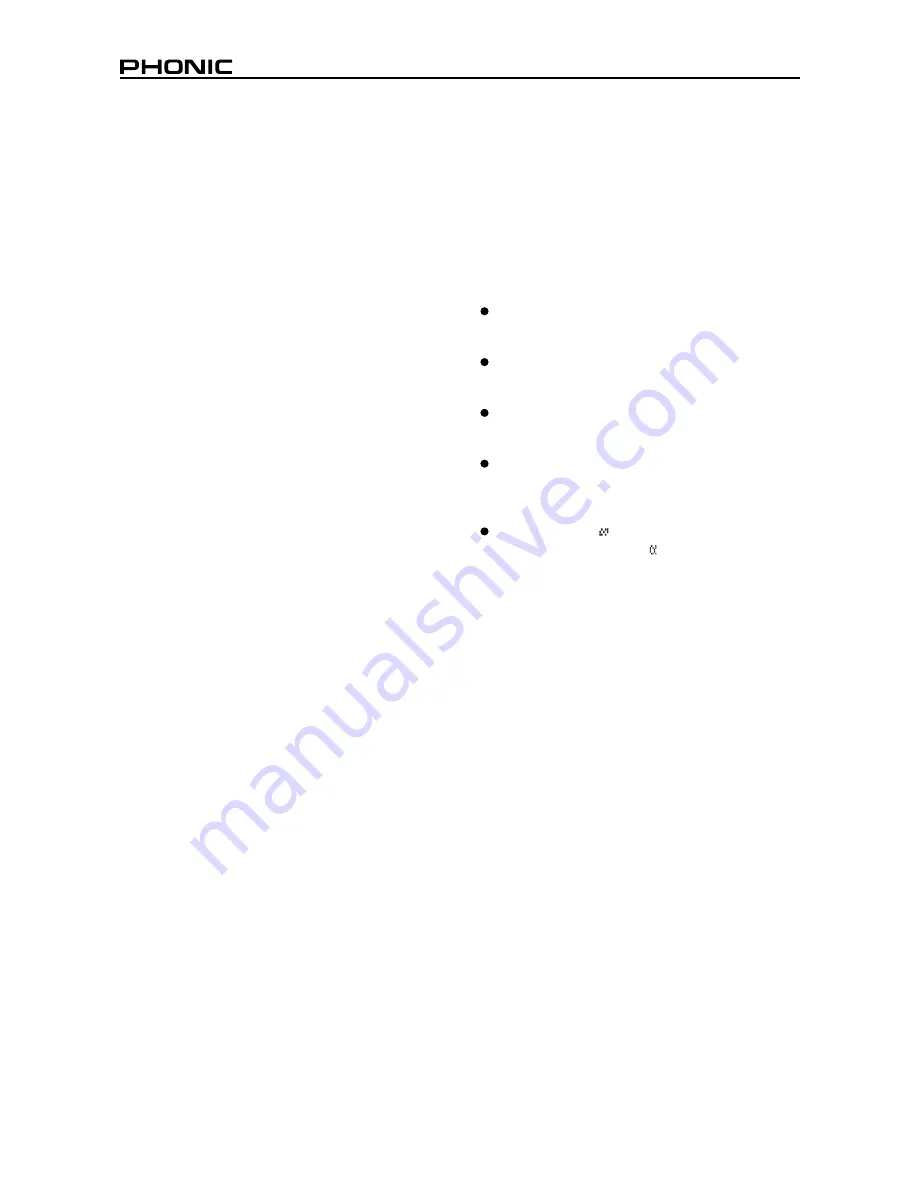
THE EQ MODULE
Controls and Display
To edit a single band
With the EQ/RTA indicator off, turning or
pushing the
GRAPHIC EDIT
knob will bring
you to the EQ Band Select Mode. See Table1
for tips on identifying the control modes. To
select a band, simply turn the
GRAPHIC EDIT
knob. The selected band is the one that has a
slow-blinking LED (the cursor). To change from
Channel 1 to Channel 2, turn the
GRAPHIC
EDIT
knob clockwise until the cursor "jumps"
to the right pane. Once a band is selected,
you can edit its boost/cut level by pushing
the
GRAPHIC EDIT
knob once. The cursor
will blink faster to indicate that you are now in
the EQ Band Edit Mode. While in this mode,
turning the
GRAPHIC EDIT
knob will boost or
cut the gain level of the band. After you are
done editing the band level, push the
GRAPHIC
EDIT
knob once again to return to the EQ Band
Select Mode.
To edit a multiband group
While in the EQ Band Select Mode, turning the
FUNCTION EDIT
knob lets you select multiple
bands as a group. For example, if the LED
is originally blinking only at the
10K
band of
Channel 1, turning the
FUNCTION EDIT
knob
clockwise by two notches will make these three
LEDs blink:
10K
,
12.5K
, and
16K
. If instead of
two notches, you turn the knob clockwise by
? ve notches, you will notice that the blinking
LEDs are no longer limited to Channel 1 (at
10K
,
12.5K
,
16K
and
20K
Hz), but also include
two bands of Channel 2 (at
25
and
31
Hz). This
means you can group across the channels even
when
Channel Link
is off. In practice, you may
often want to raise or lower the boost/cut level
of the entire spectrum of both channels. This
cross-channel grouping makes the task quick
and easy without having to link the channels.
Once a group is selected, push the
GRAPHIC
EDIT
knob to enter the EQ Band Edit Mode;
notice the LEDs are blinking faster. Now turn
the
GRAPHIC EDIT
knob to edit simultaneously
the boost/cut level of all selected bands. Push
the
GRAPHIC EDIT
knob again to return to the
EQ Band Select Mode.
Functions
With the
EQ/RTA
indicator off, pushing the
FUNCTION EDIT
knob once will bring you to
the EQ Function Select Mode. See Table 1 for
tips on identifying the control modes. While in
the EQ Function Select Mode, the upper line of
the Alphanumeric Display provides important
information on the current EQ settings. This
information includes the following ? ve values.
Program number:
P1
through
P30
are
factory-set programs, and
U1
through
U30
are user-de? ned programs.
Low-pass ? lter: The letters
LPF
appears
when the low-pass ? lter is active. This
value is channel dependent.
High-pass ? lter: The letters
HPF
appears
when the high-pass ? lter is active. This
value is channel dependent.
Gain:
G+
indicates that a gain increase is
been applied to the output;
G–
is for gain
decrease; and
G=
is for zero gain. This
value is channel dependent.
Channel link: appears when the channel
link is on. Otherwise, is displayed.
The lower line of the Alphanumeric Display
shows a function name and its current value.
When you are in the EQ Function Select
Mode, the entire lower line is ? ashing. This is
to remind you that, if you turn the
FUNCTION
EDIT
knob now, you will be "scrolling" through
the function menu. Turn the
FUNCTION EDIT
knob to ? nd the function that you want to edit.
Press the
FUNCTION EDIT
once to enter the
EQ Function Edit Mode. Notice that the function
name is no longer ? ashing and that only the
variable value is. Turning the
FUNCTION
EDIT
knob now will change the value for that
function. When you have ? nished adjusting the
value, press the
FUNCTION EDIT
knob again
to return to the EQ Function Select Mode.
The following sections describe all functions
you can adjust in the EQ Function Edit Mode.
Channel Link
When this function is set to
On
, all settings of
Channel 1 are copied to Channel 2; and all
subsequent adjustments will be simultaneously
applied to both channels. When
Channel Link
is
Off
, you can adjust each channel separately;
the location of the cursor determines which
channel is to be affected. When the cursor
is in the left pane, the adjustment is made to
8
i7600
Summary of Contents for i7600
Page 1: ...i SUPRACURVE i7600 English...
Page 6: ...s l e n a p r a e r d n a t n o r F 1 e r u g i F 6 i7600...
Page 13: ...DIMENSIONS 13 i7600...
Page 14: ...APPENDIX A FACTORY PROGRAMS 14 i7600...
Page 15: ...15 i7600...
Page 16: ...16 i7600...
Page 17: ...17 i7600...
Page 18: ...18 i7600...
Page 19: ...19 i7600...
Page 20: ...20 i7600...
Page 21: ...21 i7600...
Page 22: ...22 i7600...
Page 23: ...23 i7600...
Page 24: ...1 U 2 U 3 U APPENDIX B USER PROGRAMS 24 i7600...
Page 25: ...4 U 5 U 6 U 25 i7600...
Page 26: ...7 U 8 U 9 U 26 i7600...
Page 27: ...0 1 U 1 1 U 2 1 U 27 i7600...
Page 28: ...3 1 U 4 1 U 5 1 U 28 i7600...
Page 29: ...6 1 U 7 1 U 8 1 U 29 i7600...
Page 30: ...9 1 U 0 2 U 1 2 U 30 i7600...
Page 31: ...2 2 U 3 2 U 4 2 U 31 i7600...
Page 32: ...5 2 U 6 2 U 7 2 U 32 i7600...
Page 33: ...8 2 U 9 2 U 0 3 U 33 i7600...
Page 35: ......























